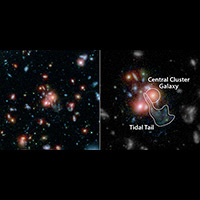Astronomers have discovered a rare beast of a galaxy cluster whose heart is bursting with new stars. The unexpected find, made with the help of NASA's Spitzer and Hubble space telescopes, suggests that behemoth galaxies at the cores of these massive clusters can grow significantly by feeding off gas stolen from other galaxies.
"Usually, the stars at the centers of galaxy clusters are old and dead, essentially fossils," said Tracy Webb of McGill University, Montreal, Canada, lead author of a new paper on the findings published in the Aug. 20 issue of The Astrophysical Journal. "But we think the giant galaxy at the center of this cluster is furiously making new stars after merging with a smaller galaxy."
Galaxy clusters are vast families of galaxies bound and grouped by the ties of gravity. Our own Milky Way resides in a small galaxy group, called the Local Group, which itself is on the periphery of the vast Laniakea supercluster of 100,000 galaxies. (Laniakea is Hawaiian for "immeasurable heaven.")

The cluster in the new study, referred to by astronomers as SpARCS1049+56, has at least 27 galaxy members, and a combined mass equal to nearly 400 trillion suns. It is located 9.8 billion light-years away in the Ursa Major constellation. The object was initially discovered using Spitzer and the Canada-France-Hawaii Telescope, located on Mauna Kea in Hawaii, and confirmed using the W.M. Keck Observatory, also on Mauna Kea.
What makes this cluster unique is its luminous heart of new stars. At the core of most massive galaxy clusters lies one hulking galaxy that usually doesn't produce new stars very quickly. The galaxy dominating the cluster SpARCS1049+56 is rapidly spitting out an enormous number of stars — about 860 new ones a year. For reference, our Milky Way makes only about one to two stars per year.
For a little more insight into the project see this:
http://hubblesite.org/newscenter/archive/releases/2015/32/
